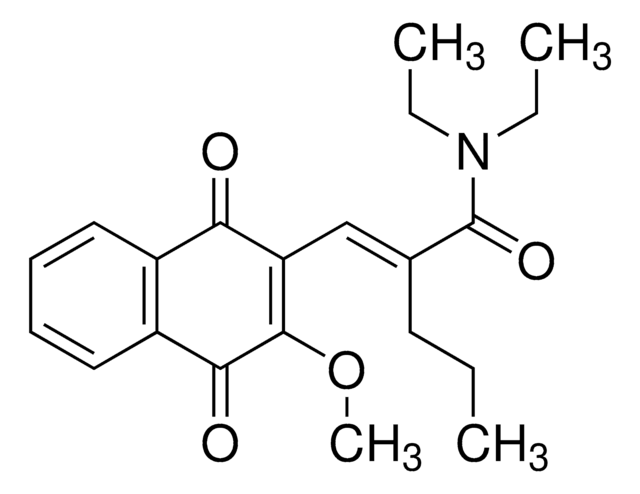E8534
E3330
≥98% (HPLC)
Synonim(y):
(2E)-2-[(4,5-Dimethoxy-2-methyl-3,6-dioxo-1,4-cyclohexadien-1-yl)methylene]-undecanoic acid
About This Item
Polecane produkty
Poziom jakości
Próba
≥98% (HPLC)
Postać
powder
kolor
red to orange
rozpuszczalność
DMSO: >20 mg/mL
temp. przechowywania
2-8°C
ciąg SMILES
CCCCCCCCC\C(=C/C1=C(C)C(=O)C(OC)=C(OC)C1=O)C(O)=O
InChI
1S/C21H30O6/c1-5-6-7-8-9-10-11-12-15(21(24)25)13-16-14(2)17(22)19(26-3)20(27-4)18(16)23/h13H,5-12H2,1-4H3,(H,24,25)/b15-13+
Klucz InChI
AALSSIXXBDPENJ-FYWRMAATSA-N
Zastosowanie
Działania biochem./fizjol.
Zwroty wskazujące rodzaj zagrożenia
Zwroty wskazujące środki ostrożności
Klasyfikacja zagrożeń
Aquatic Chronic 4
Kod klasy składowania
11 - Combustible Solids
Klasa zagrożenia wodnego (WGK)
WGK 3
Temperatura zapłonu (°F)
Not applicable
Temperatura zapłonu (°C)
Not applicable
Certyfikaty analizy (CoA)
Poszukaj Certyfikaty analizy (CoA), wpisując numer partii/serii produktów. Numery serii i partii można znaleźć na etykiecie produktu po słowach „seria” lub „partia”.
Masz już ten produkt?
Dokumenty związane z niedawno zakupionymi produktami zostały zamieszczone w Bibliotece dokumentów.
Nasz zespół naukowców ma doświadczenie we wszystkich obszarach badań, w tym w naukach przyrodniczych, materiałoznawstwie, syntezie chemicznej, chromatografii, analityce i wielu innych dziedzinach.
Skontaktuj się z zespołem ds. pomocy technicznej








